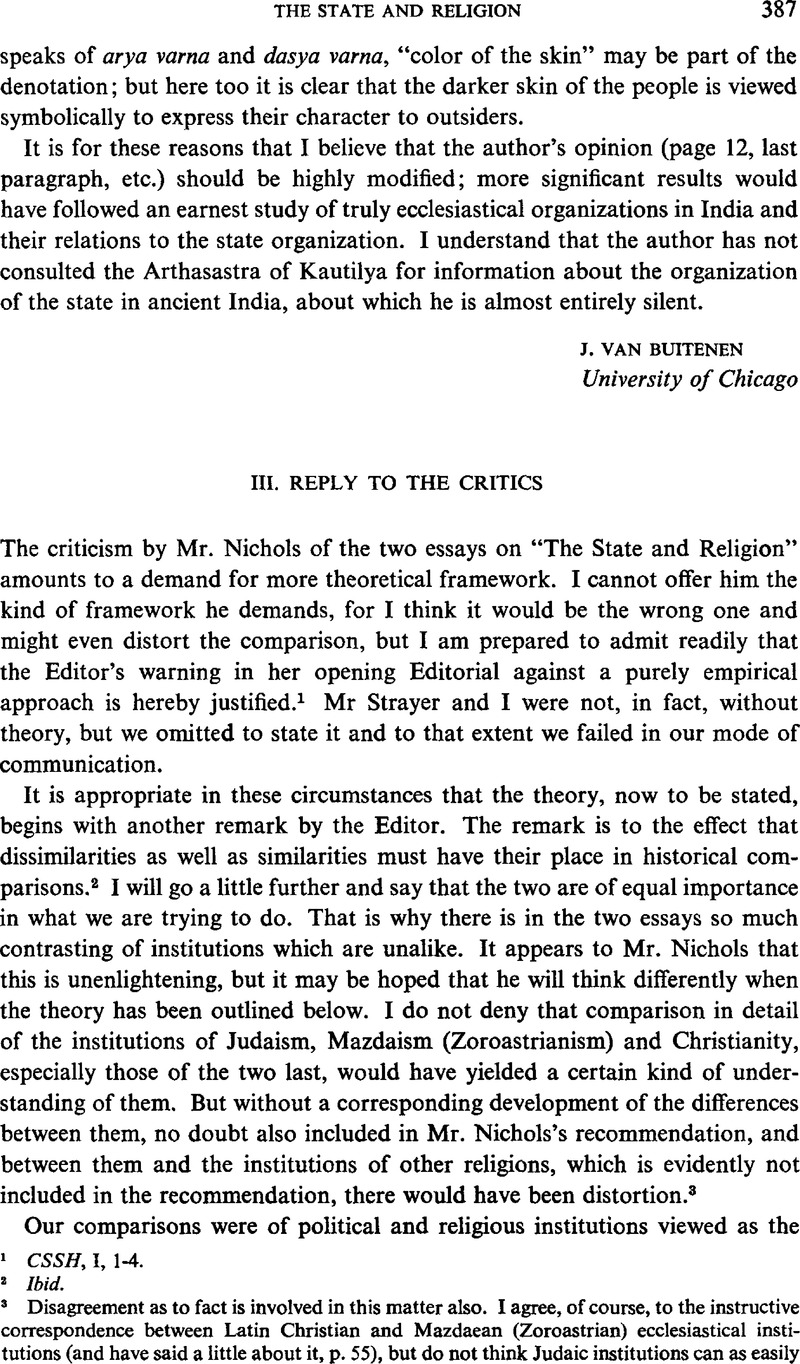No CrossRef data available.
Article contents
III. Reply to the Critics
Published online by Cambridge University Press: 03 June 2009
Abstract

- Type
- Debate
- Information
- Copyright
- Copyright © Society for the Comparative Study of Society and History 1959
References
1 CSSH, 1,1–4.Google Scholar
2 Ibid.
3 Disagreement as to fact is involved in this matter also. I agree, of course, to the instructive correspondence between Latin Christian and Mazdaean (Zoroastrian) ecclesiastical institutions (and have said a little about it, p. 55), but do not think Judaic institutions can as easily be included; from what we know of them, they might be described as transitional from another type - significantly, from the Egyptian type.
I believe there is little similarity between Hindu religious institutions on the one hand and Graeco-Roman and Chinese (pre-Confucianist and Confucianist) institutions on the other, but I contributed to this error by failing to show the relation of Hindu religious institutions to the linear scheme put forward, CSSH, I, 56.Google Scholar
There seems to be some confusion at this latter point between the institutions and the religions themselves considered as total social phenomena. The distinction between the two groups, as total religions, is fathered on Söderblom - on the whole justifiably although Söderblom was at least aware that the “exclusive religions of historical revelation” were, as may be said, impure; that is to say, they had, besides their revelations, beliefs and practices of the same sort as culture or nature religions (see Söderblom, Nathan, La Vie d'après le Mazdeéisme,Paris, 1901, pp. 1–2Google Scholar). It may be argued perhaps that in their “cultural” and “natural” elements Hindu, Chinese, and Graeco-Roman religion have something in common, but I think not much, and, much or little, it can have had little effect on institutions.
4 For Toynbee, both in his errors and his profound insights, see my “Fact and Fiction in Toynbee's Study of History,” Ethics, LXVI (1956), 235–249.Google Scholar
5 For a critical inventory of the work of all these scholars, see Kroeber, A. L., Style and Civilizations (Ithaca, 1957)Google Scholar, and for the rise and fall theme, treated analytically and with the most uncompromising adherence to empirical fact, Kroeber's, Configurations of Culture Growth (Berkeley, 1944).Google Scholar
6 I do not mean by this strong statement to reject all other bases of comparison, but merely to say that the basis of civilized societies is the broadest one the historian can use. Both nations and civilized societies are “intelligible fields of study” (Toynbee), but for different purposes, the latter for the largest purposes of all.
7 Cf. above, n. 3.
8 As cited in n. 3 above.
9 I am very much obliged to Mr. van Buitenen for the list of works he furnished me when I asked to be enlightened as to the authority for some of his opinions. I did not, however, find among them justification for these statements. Nor have I found it anywhere else. Mea culpa, perhaps.
10 Caste in India(London, 1930), p. 73.Google ScholarPubMed
11 Prehistoric India (Harmondsworth, England, 1950), pp. 201–203.Google ScholarPubMed
12 The Art of Indian Asia, ed. Campbell, J. and Bollingen, Ser., No. XXXIX, I (New York, 1955),21, 158–160Google Scholar; Myths and Symbols in Indian Art and Civilization, ed. Campbell, J. and Bollingen, Ser., No. VI (Washington, 1946), passim.Google Scholar
13 Hocart's argument (Hocart, A. M., “Les Castes”, Annales du Muséle Guimet, tome 54, Paris, 1938, pp. 29–30 and passimGoogle Scholar) that caste originated for sacrificial purposes is very interesting, but it cannot be the whole explanation of the origin of caste. It is reasonable to think that the small groups of artisans, clans, etc. existed long before the rise of caste to its special place in Indian institutions, that they were obvious units to enlist in a political struggle, and that their religious functions achieved special importance by reason of the influence of the Brahmans upon them in the course of the struggle.


